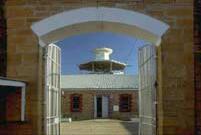
CONTACT INFORMATION
Southern Flinders Discovery
Centre for Tourism Information
14 Gladstone Street
Gladstone South Australia
(PO Box 3 Gladstone SA 5473)
Telephone - 08 8662 2226
Email - sfdiscovery@gladstone.org.au
Gladstone Community Development and Tourism Association
Email - gcdta@gladstone.org.au
District Council of Rocky River
PO Box 94
Gladstone SA 5473
Telephone - 08 8662 2018
LINKS




ARTICLES ON THE CITY OF GLADSTONE
![]()
Located 209 km north of Adelaide,
Gladstone is a medium-sized service town in an area dominated
by wheat and sheep
Even today the town boasts the largest grain silos in South Australia
The first Europeans into the area took up the 'Booyoolie (sometimes
spelt 'Booyoolee') Run' in 1851
Some of the original buildings dating from this period are still
standing
It wasn't until 1871 that the town was formally surveyed and the
name Gladstone - an honour to the British Prime Minister William
Gladstone - was given to the new settlement
This resulted in the strange situation where there were two tiny
settlements - Booyoolie and Gladstone - until the 1940s when they
finally agreed to accept Gladstone as the term to apply to both
of them
The town developed rapidly with the arrival of the railway in
1877
It was built to ship wheat from the town's grain silos to Port
Pirie
Today trains still use the line but the largest use is for the
transportation of lead and zinc from Broken Hill to Port Pirie
The appeal of the town lies in its broad streets and substantial
buildings
The Commercial Hotel which dates from 1878 and has some particularly
attractive lattice work, the Gladstone Hotel offers accommodation,
and the most impressive buildings in town are the bank buildings
which dominate the street beside the railway line
The famous Australian poet, C. J. Dennis, lived in the town as
a child
His father ran the local hotel and Dennis attended the local primary
school

The Gladstone Gaol
The town's main attraction is Gladstone Gaol, located in Park
Terrace at the northern end of town, which was built between 1879-81
at a cost of £21,640
The slate was quarried at Mintaro and transported by bullock draying
It was originally used for 'inebriates and debtors'
It was never a large gaol and from the time of its opening until
the 1920s it never housed more than twenty prisoners
From its earliest days it was always a gaol for both men and women
During World War II it was used as an internment camp for Italians
and Germans
After 1943 it remained unused until 1953 when it became a corrective
training complex for 18-25-year-old offenders
It was reasonably secure
There were only twenty escapes in the gaol's 100 year history
It was eventually closed down in 1975 and opened to visitors in
1978
It is open now for inspection and for backpacker accommodation
Open weekends and public holidays from 9:00am to 4:00pm - weekdays
from 1:00pm to 4:00pm
Contact (08) 8662 2200 for details
Railway Yards
Train spotters come to Gladstone to see one of the wonders of
the railway world
It is here that three railway gauges - the narrow, standard and
broad gauge - all meet
At the railway yards it is possible to see the three gauges beside
each other

Few folk would be happy to
claim a lockup as their town’s greatest tourist attraction,
but, when it comes to prisons, Gladstone Gaol is one right out
of the history pages
Two years in the building, Gladstone Gaol opened in 1881 to provide
temporary quarters for ‘inebriates, debtors and other prisoners’
Its guest list remained basically unaltered until the early days
of World War II when it was used for the internment of German
and Italian nationals and subsequently, as a military detention
centre
The Germans and Italians were allowed to return to their Australian
homes at war's end and the lock-up remained empty until 1953 when
it was recommissioned as a medium security gaol for young prisoners
In 1975 it was deemed to be outdated and its inmates were transferred
to other gaols
Three years later its doors were thrown open to visitors
Today the gaol shares the Gladstone heritage spotlight with the
Gladstone Hotel which was the childhood home of Australian poet,
C.J. Dennis
Dennis lived in the hotel, which his father owned, from the age
of seven to thirteen and no doubt picked up some characteristics
of the Sentimenal Bloke and Ginger Mick from the Gladstone regulars